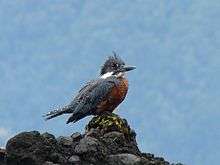Ringed kingfisher
| Ringed kingfisher | |
|---|---|
.jpg) | |
| Male | |
 | |
| Female | |
| Scientific classification | |
| Kingdom: | Animalia |
| Phylum: | Chordata |
| Class: | Aves |
| Order: | Coraciiformes |
| Family: | Cerylidae |
| Genus: | Megaceryle |
| Species: | M. torquata |
| Binomial name | |
| Megaceryle torquata (Linnaeus, 1766) | |
 | |
| The distribution of the ringed kingfisher | |
| Synonyms[2] | |
|
Ceryle torquata | |
The ringed kingfisher (Megaceryle torquata) is a large, conspicuous and noisy kingfisher commonly found along the lower Rio Grande valley in southeasternmost Texas in the United States through Central America to Tierra del Fuego in South America.
The breeding habitat is areas near large bodies of water, usually in heavily wooded areas where it finds a perch to hunt from. It is mostly a sedentary species, remaining in territories all year long.
It is 40 to 41 cm (16–16 in) long, with deep blue or bluish-gray plumage with white markings, a shaggy crest and a broad white collar around the neck. Its most distinguishing characteristic is the entirely rufous belly, which also covers the entire breast of the male. Females are more colorful than the male and have a bluish-gray breast and a narrow white stripe separating the breast from the belly.
These birds nest in a horizontal tunnel made in a river bank or sand bank. The female lays 3 to 6 eggs. Both parents excavate the tunnel, incubate the eggs and feed the young.
It is often seen perched prominently on trees, posts, or other suitable "watchpoints" close to water before plunging in head first after its fish prey. They also eat insects and small amphibians.
Their voice is a loud, penetrating rattle given on the wing and when perched.
The Megaceryle kingfishers were formerly placed in the genus Ceryle with the pied kingfisher, but the latter is genetically closer to the American green kingfishers.
Gallery
-

-

Ringed kingfisher near Hornopirén, Chile
References
- ↑ BirdLife International (2012). "Megaceryle torquata". IUCN Red List of Threatened Species. Version 2013.2. International Union for Conservation of Nature. Retrieved 26 November 2013.
- ↑ Megaceryle torquata on Avibase
External links
| Wikimedia Commons has media related to Megaceryle torquata. |
| Wikispecies has information related to: Megaceryle torquata |
- Ringed kingfisher stamps for Antigua, Dominica, Nevis, Nicaragua, Suriname at bird-stamps.org
- Ringed kingfisher videos, photos, and sounds at the Internet Bird Collection
- Ringed kingfisher photo gallery at VIREO (Drexel University)
- Ringed Kingfisher species account at NeotropicalBirds (Cornell University)
